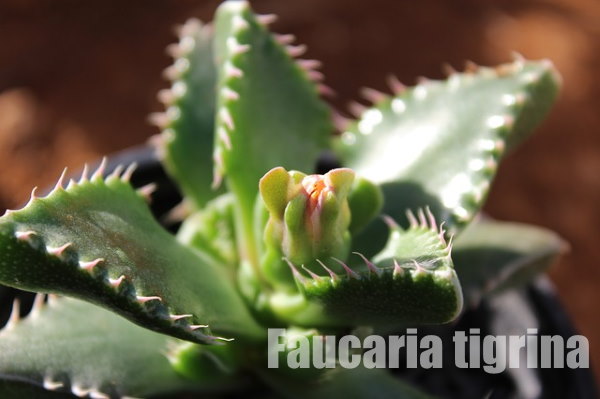Tiger’s Jaw – Faucaria tigrina Succulent Care Tips for Indoor Growing
Botanical Name: Faucaria tigrina
Tiger’s Jaw lives up to its common name. The sharp spines that edge the pairs of speckled leaves look like the teeth of a ferocious tiger. Their low-growing habit and unusual leaves make a spectacular addition to a succulent dish garden.
These South African succulents grow in clumps of stemless, star-shaped rosettes in its dry, rocky native habitat. Give them the same hot, dry, sunny environment and they’ll feel right at home.
 Tiger’s Jaw succulent is ready to bloom. Photo: Image by J_0
Tiger’s Jaw succulent is ready to bloom. Photo: Image by J_0In fall, yellow, daisy-like flowers may appear on plants that are a few years old. However, they won’t bloom without 3-4 hours of direct sun each day during the summer. Moving your plant outdoors for the summer will give it the light these succulents need.
Tiger’s Jaw prefers slightly cooler temperatures in the winter, but this succulent is not cold-hardy. If you move it outdoors for the summer, be sure to bring it back indoors when nighttime temperatures drop below 60°F/16°C.
Winter care. Give Faucaria tigrina a rest in winter. Cut back on water, stop fertilizing, and provide average room temperatures and full sunlight — a sunny window is ideal. In spring, resume normal care.
Wondering when to repot? Repot every 2-3 years, or when they outgrow their containers. Tiger’s Jaw succulents have small roots, so you can grow them in shallow containers. Be sure the pots have drainage holes to prevent root rot.
Something bugging your plant? Mealybugs are small insects that look like little tufts of white fuzz and are the most common pest found on succulents. Many people mistakenly believe there is only one type of mealybug; however, there are several species, which can invade leaves, stems and roots of plants. Check over your plant and treat any infestation immediately.
Tiger’s Jaw Care Tips
Origin: South Africa
Height: Up to 6 in (15 cm)
Light: Bright light with some direct sun. Faucaria tigrina needs at least 3-4 hours of direct sunlight to bloom.
Water: Keep soil lightly moist spring through fall. In winter, allow soil to dry out between waterings.
Humidity: Average room (around 30-40% relative humidity)
Temperature: Warmer spring through fall 70-90°F/21-32°C. Average temperatures in winter, 60-75°F/16-24°C.
Soil: Cactus and Succulent Potting Mix. Or use 2 parts potting mix with 1 part sand.
Fertilizer: Feed every 2 weeks spring through fall with a 2-7-7 liquid plant food diluted by half.
Do not feed in winter.
Propagation: Offsets will grow at the base of the parent plant. Cut them away with a sharp knife. Allow the
cut surface to dry for a day so it doesn’t ooze sap and to prevent the new plant from rotting. Plant the offsets in a
lightly moist, sandy potting mixture. Keep new offsets in a warm, bright place, but out of direct sun for the first month.
The best time to propagate is late spring to early summer, when succulents are beginning their most active period of growth.




